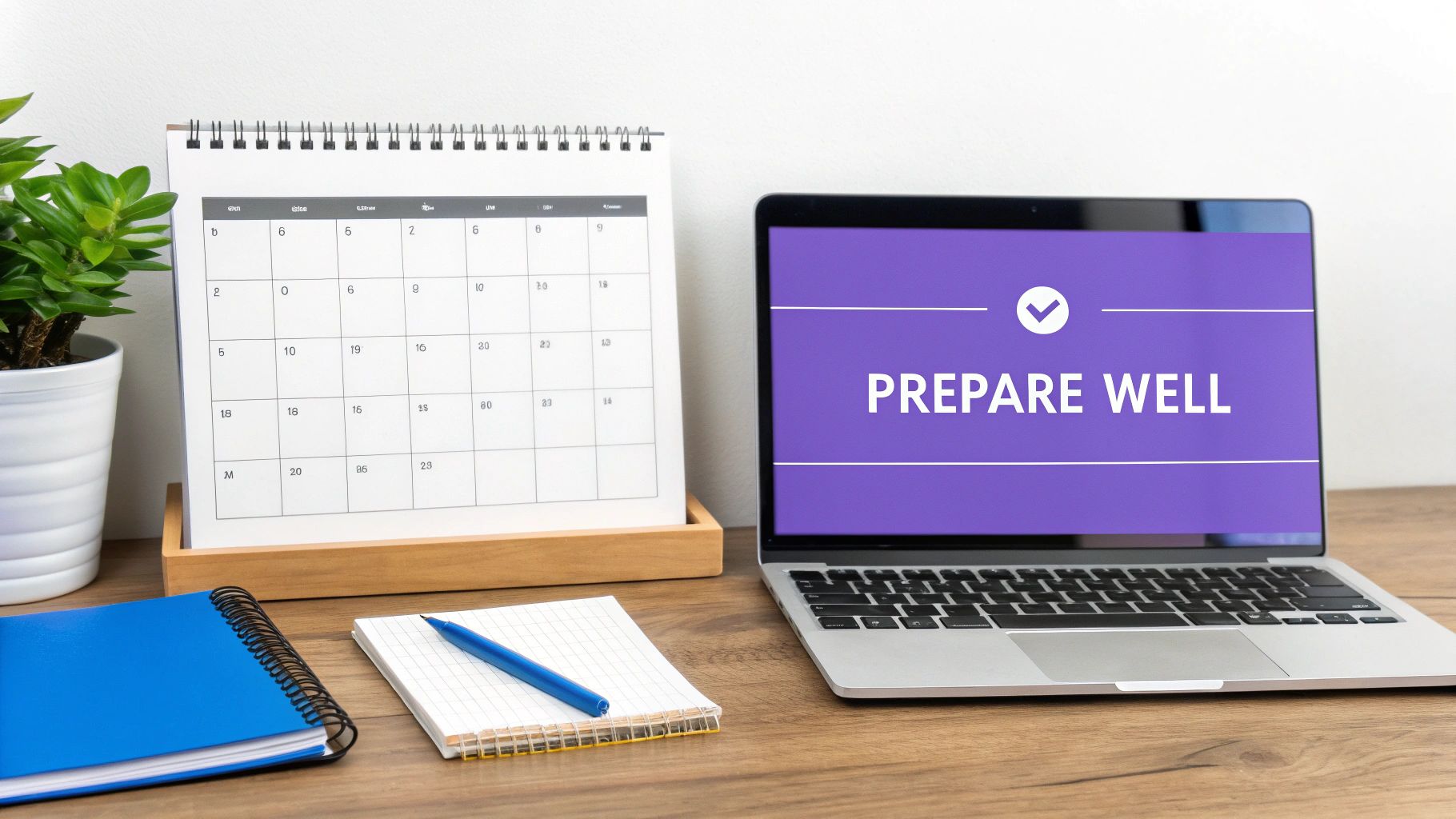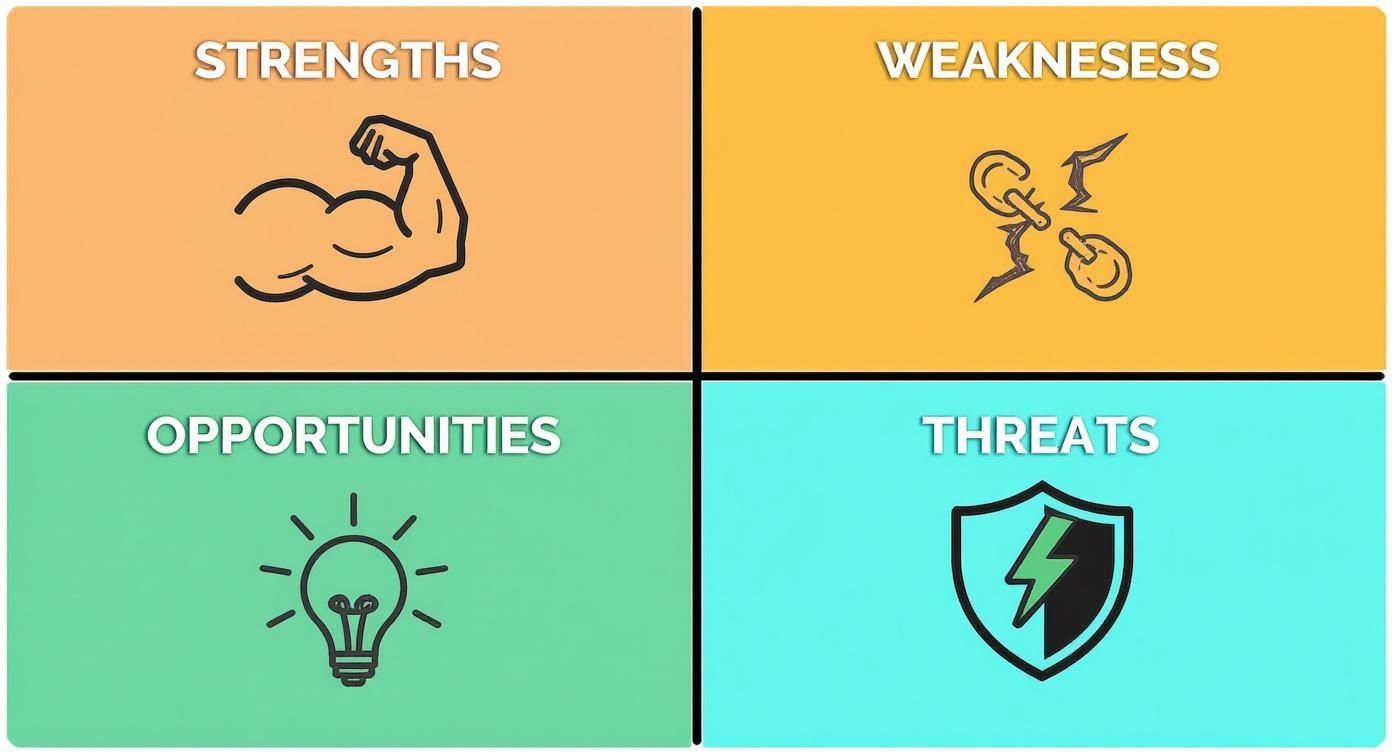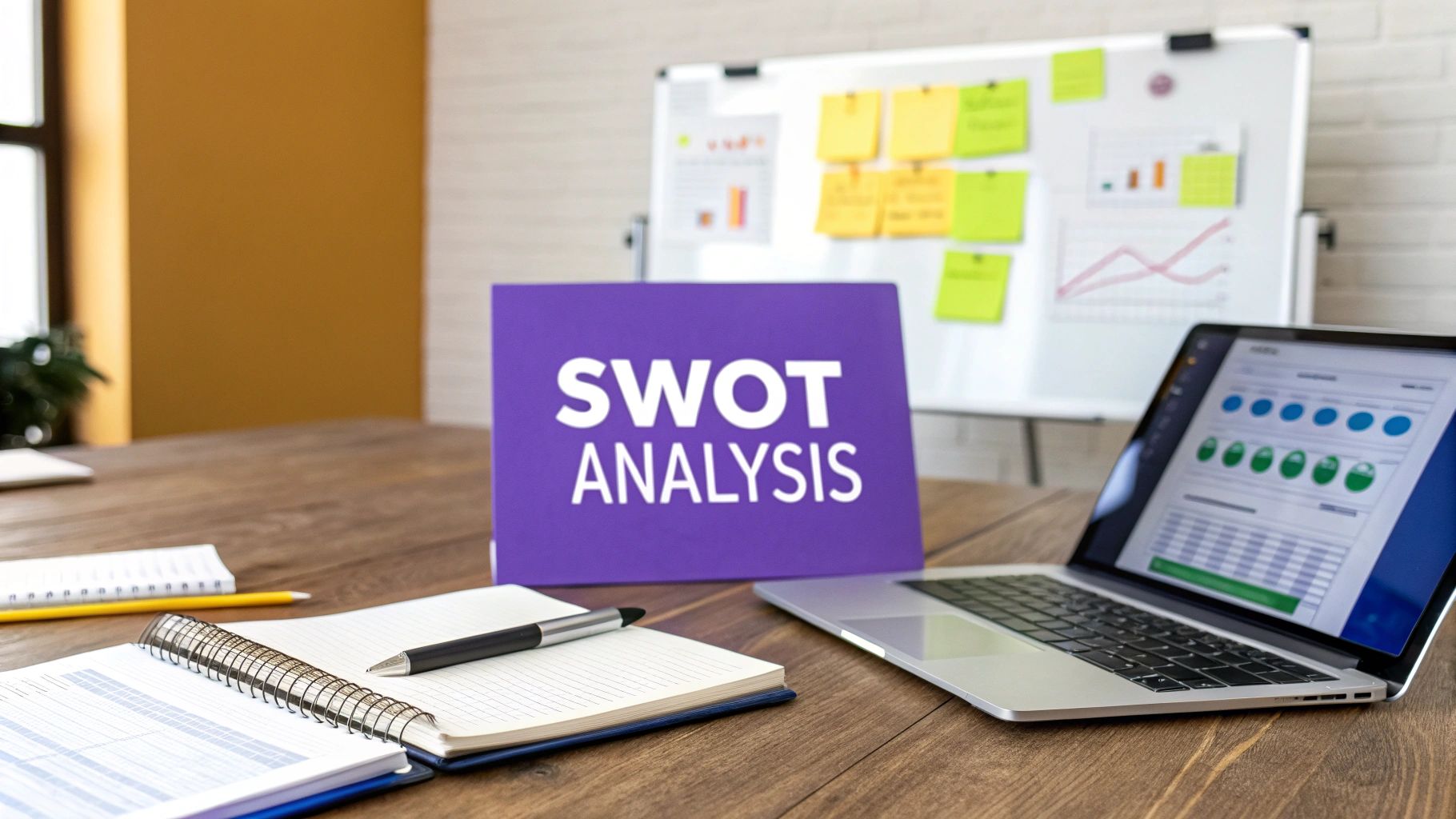A SWOT analysis is all about taking a hard look at your organization's internal Strengths and Weaknesses alongside its external Opportunities and Threats. It’s a straightforward framework, but it delivers the kind of clarity you need to make smarter business decisions and build a strategy that actually works.
Why a SWOT Analysis Is a Game-Changer for Strategy

It’s easy to dismiss SWOT analysis as just another tired business school exercise. I’ve seen teams do it. But that’s a huge mistake. When you do it right, it becomes a powerful tool that gets everyone on the same page and helps you carve out a real competitive advantage. It stops being a simple list on a whiteboard and turns into a cornerstone of your strategic plan.
The framework’s real power comes from its structure, which forces you to examine your business from four different angles. This process often brings hidden connections to light, like seeing how a unique internal strength can help you jump on an emerging market opportunity. To really get why this is so crucial for your company's direction, it helps to understand the fundamentals of strategic planning in business.
Moving from Theory to Action
The real value of a SWOT analysis shows up when you start connecting the dots between the quadrants.
Picture a tech startup whose biggest strength is a highly skilled and agile engineering team. An opportunity pops up: a new AI integration that bigger competitors are too slow to adopt. By linking that strength to the opportunity, the startup can shift its resources and grab a first-mover advantage.
It works the other way, too, flagging risks before they blow up. A local restaurant might recognize its limited marketing budget as a major weakness. A threat then appears in the form of a big chain opening down the street with a huge ad budget. This insight pushes the restaurant to get creative with low-cost, high-impact tactics—like local partnerships and social media—instead of trying to win a spending war it can't afford.
The Evolution of a Classic Tool
The SWOT analysis has been around since the 1960s, but it has come a long way from its academic origins. The core goal is the same: to identify internal Strengths and Weaknesses alongside external Opportunities and Threats to guide your next move. What’s changed is how we do it. Cloud-based platforms are now common, with adoption growing fast among businesses of all sizes across North America, Europe, and Asia Pacific.
The magic of a proper SWOT analysis is that it turns abstract feelings about your business into concrete, actionable insights. It’s the bridge between where you are and where you want to go.
Setting the Stage for a Powerful SWOT Session

Here's a hard-earned lesson: the success of a SWOT analysis is often decided before anyone even walks into the room. A bit of focused prep work is what separates a rambling, unfocused meeting from a session that delivers real, strategic gold. It all starts with who you invite.
Get the Right People (and Data) in the Room
Your first instinct might be to pack the room with senior leaders. Resist it. The most powerful insights come from a mix of perspectives across different departments. You need people from sales, marketing, operations, and product development—the folks on the front lines who know what’s really going on. Their ground-level view is pure gold.
Try to keep the group between six to ten people. That’s the sweet spot—big enough for diverse ideas, but small enough that everyone feels they can speak up.
When you send the invite, be incredibly clear about the objective. Vague goals like "Let's review the business" lead to vague results. Instead, frame the session around a specific question you need to answer.
For instance, you could focus on:
- "Should we invest in building a mobile app this year?"
- "How do we protect our market share from this new competitor?"
A sharp, focused objective gives everyone a clear target to aim for.
Next, arm your team with data. Walking in empty-handed and relying on opinions is a recipe for a weak analysis. Pull together customer feedback, sales reports, competitor research, and market trends beforehand. This isn't just nice to have; it's essential for grounding the conversation in reality.
Don’t mistake a SWOT session for a brainstorming free-for-all. It's a structured analysis. Giving people data ahead of time helps them move beyond gut feelings and bring evidence-based ideas to the table.
Your SWOT Analysis Preparation Checklist
To make sure you've covered all your bases, I've put together a quick checklist. Running through these steps will set your team up for a much more productive and insightful session.
| Preparation Step | Key Action | Why It's Important |
|---|---|---|
| Define the Objective | Frame the session around a single, specific strategic question. | A clear goal prevents the discussion from becoming too broad and keeps everyone focused. |
| Select Your Team | Invite 6-10 people from various departments and levels. | Diverse perspectives uncover blind spots and lead to a more comprehensive analysis. |
| Gather Relevant Data | Collect market trends, competitor info, and internal performance metrics. | Data grounds the conversation in facts, not just opinions, leading to stronger insights. |
| Create a Clear Agenda | Allocate specific time blocks for each quadrant and schedule breaks. | An agenda keeps the session on track, respects everyone's time, and ensures all areas are covered. |
| Appoint a Facilitator | Choose someone to guide the discussion, manage time, and ensure participation. | A neutral facilitator can draw out quieter voices and steer the conversation back on course. |
Following this checklist ensures you’re not just hoping for a good outcome—you’re planning for one.
An Agenda is Your Best Friend
A tight, well-planned agenda is your best defense against those classic meeting-derailers: tangents and circular conversations. It keeps the energy up and ensures you give each of the four quadrants the attention it deserves. This is even more critical for remote teams using a tool like Bulby, where a clear structure is key to keeping everyone engaged.
If you need a solid starting point, this workshop planning template is a great resource for structuring your session.
Finally, pick a facilitator. This person’s job isn’t to add their own ideas, but to be the guide. They manage the clock, steer the conversation, and make sure every voice in the room is heard—especially the quiet ones. A great facilitator knows when to challenge the group to dig deeper and when to move on, turning a good meeting into a game-changing one.
Running the Brainstorming Session Quadrant by Quadrant
Alright, this is where the magic happens. The brainstorming session is the engine of your entire SWOT analysis, and your job is to keep it running smoothly.
The best way I’ve found to do this is to tackle one quadrant at a time. It keeps the conversation tight and stops people from jumping all over the place. If you don't, you'll find an "opportunity" comment popping up while you're trying to dig into "weaknesses," and the whole thing can get messy fast.
Timeboxing is Your Best Friend
To keep the momentum going, I recommend timeboxing each quadrant. Give the team a dedicated 20-25 minutes per section. This creates a bit of urgency and ensures you don't get bogged down. Your main goal here is to get everyone talking openly, especially when you hit the tougher topics.
Kick Things Off With Strengths
Always start with Strengths. It gets the ball rolling on a positive note and helps build a good vibe for the rest of the session. We're looking for the internal, positive things your team absolutely nails—the stuff you control and can be proud of.
Instead of generic questions, try to spark a real conversation with prompts like these:
- What’s the one thing our customers rave about in reviews or emails? Let's get specific.
- Do we have any secret weapons? Think unique resources, tech, or talent that our competitors can't touch.
- Which of our internal processes are so smooth they practically run themselves?
Vague answers won't cut it. "Good customer service" is nice, but it's not a strength. A real strength is "a 24-hour ticket response time with a 95% customer satisfaction rating." That’s something you can actually work with.
Face the Facts: Weaknesses
Now for the tricky part: Weaknesses. This is often the most uncomfortable quadrant, so a good facilitator is absolutely essential. You need to make it crystal clear that this isn't about pointing fingers—it's about finding areas to improve.
Anonymity can be a game-changer here. Tools like Bulby or even just anonymous virtual sticky notes allow people to be brutally honest without fearing repercussions.
Try framing the questions in a constructive way:
- Where are our competitors consistently eating our lunch?
- What are the top complaints we hear from customers? What about from our own team members?
- If you had a magic wand, what’s the one internal problem you'd fix instantly?
The most valuable insights often come from the most uncomfortable conversations. Creating a psychologically safe space for people to be honest about weaknesses is non-negotiable for a successful SWOT.
Look to the Horizon: Opportunities
With the internal review done, it’s time to look outside the company at Opportunities. These are the external tailwinds you could potentially catch. This part of the conversation is all about forward-thinking—spotting market trends, gaps, or shifts that play to your strengths. Using a well-structured brainstorming session template can really help guide this part of the discussion.
Get the team thinking with prompts like:
- Is there a new technology or market trend we could realistically jump on?
- Are there customer groups out there that nobody is properly serving yet?
- Could any upcoming changes in regulations or the economy actually help us?
Prepare for Storms: Threats
Finally, let's talk about Threats. Just like opportunities, these are external factors, but they’re the ones that could cause real harm. This isn't about being a pessimist; it’s about being a realist. Identifying potential storms on the horizon is the first step to building a ship that can withstand them.
Get the discussion started with these questions:
- What shifts in the market could make what we do less important tomorrow?
- What are our biggest competitors up to that should be keeping us up at night?
- Are there any economic clouds or tech disruptions on the horizon that could pose a risk?
Good data makes all the difference here. For instance, when Starbucks was expanding, they used SWOT to identify their strength in ethical sourcing. They saw this aligned perfectly with a growing consumer demand for sustainable products—a trend favored by over 65% of some demographics. This insight wasn't just a bullet point; it became a core part of their brand story. You can see more examples of how top companies put this into practice in this detailed guide from Edstellar.
Turning Your SWOT Findings into an Actionable Strategy
A SWOT analysis that doesn't lead to action is just an academic exercise. The brainstorming session is fantastic for getting ideas on the table, but the real magic happens when you start connecting those ideas to build a solid plan. Leaving your findings on a whiteboard is like mining for gold and leaving the nuggets in the dirt.
The crucial next step is to bridge the gap between all those insights and actual execution. A powerful way to do this is by looking for connections between the four quadrants. It’s not just about listing your Strengths; it’s about figuring out how to use them to jump on Opportunities or shield yourself from Threats. This is where your raw list of ideas starts to look like a real strategy.
Connecting the Dots for Strategic Action
You can start building out strategic options by deliberately pairing items from different quadrants. This really forces you to think about how your internal reality—the stuff you can control—interacts with the external environment.
Here are the main connections you'll want to explore:
- Strengths-Opportunities (SO): How can you use what you’re great at to take advantage of emerging opportunities? This is your classic "go for it" growth strategy.
- Strengths-Threats (ST): How can you leverage your strengths to minimize or even neutralize external threats? Think of this as using your best assets for defense.
- Weaknesses-Opportunities (WO): How can you use an opportunity to fix or improve one of your internal weaknesses? This might mean investing in new skills, tech, or people.
- Weaknesses-Threats (WT): This is your most defensive stance. What do you absolutely have to do to stop your weaknesses from making you vulnerable to threats?
The goal isn't just to identify these pairings but to generate specific, actionable initiatives from them. An action isn't 'Improve marketing.' It's 'Launch a targeted LinkedIn ad campaign for our new B2B feature by the end of Q3.'
From a Long List to a Focused Roadmap
Once you’ve gone through that exercise, you’ll probably have a very long list of potential actions. Don't fall into the trap of trying to do everything—that’s a surefire way to accomplish nothing. Prioritization is everything.
I like to start by grouping similar ideas. You’ll often find that several smaller action items can be rolled into a single, more impactful project. Once you have them grouped, get the team back together for a quick voting session. Give everyone a limited number of "votes," say, five sticky dots they can place on the initiatives they believe are most critical.
This simple exercise is incredibly effective. It quickly shows you where the team’s consensus lies and focuses your energy on what truly matters. After you've identified your top three to five initiatives, you're ready to build them into a proper roadmap. For a deeper dive into this part of the process, check out our guide on the core strategic planning process steps.
This infographic illustrates the core components of a SWOT analysis, visualizing the internal and external factors that shape your strategy.

The visualization breaks down the analysis into four key areas, helping teams organize their thoughts and prepare for strategic action.
A Modern Approach to SWOT Analysis
The good old SWOT analysis isn't static; it continues to evolve. By 2025, we're seeing it integrate more advanced tech like AI and real-time data to help tackle today's complex business challenges.
In fact, about 70% of larger companies have started weaving Environmental, Social, and Governance (ESG) factors into their SWOT analyses. This helps them better align their strategies with what their customers, employees, and investors actually care about. This shift just goes to show how a classic tool can stay relevant by adapting to new business priorities.
Common SWOT Analysis Mistakes to Avoid
Just about anyone can run a SWOT analysis, but running a good one? That's a different story. Too many teams treat it like a box-checking exercise, and they end up with a document full of vague ideas that collects digital dust.
The good news is that most of the common missteps are surprisingly easy to avoid once you know what they are. Let’s walk through them.
The biggest mistake I see, time and time again, is being way too general. When a team lists "strong marketing" as a strength, it's a feel-good platitude, not a strategic insight. It doesn't give you anything to work with.
From Vague Notions to Concrete Facts
The fix is simple: challenge every single point with evidence. Push your team to back up their claims with real data or specific examples. This one shift can transform your entire analysis from a collection of opinions into a foundation for solid strategy.
Here’s what that looks like in practice:
-
Instead of: "Good marketing"
-
Try: "A highly engaged email list of 50,000 subscribers with a 40% open rate."
-
Instead of: "Great team"
-
Try: "An engineering team with a proven track record of shipping major product updates every six weeks."
See the difference? One is a fuzzy idea, the other is a tangible asset you can build on. This forces everyone to ground their assumptions in reality, which is the whole point of this exercise.
Another classic blunder is mixing up what's happening inside your company versus outside. Strengths and Weaknesses are internal—they are things you have some control over. Opportunities and Threats are external forces out in the market. "Outdated internal software" is a weakness. "A new competitor" is a threat. Getting this right keeps your thinking clear and your strategy focused.
Avoiding Bias and Prioritizing Ruthlessly
Failing to prioritize is another way these sessions go off the rails. You might finish brainstorming with 15 ideas in every quadrant, but a list of 20 "opportunities" is just as paralyzing as having none. If your SWOT analysis doesn't lead to a tight, focused action plan, it hasn't done its job.
A successful SWOT analysis isn't about creating the longest list; it's about identifying the vital few factors that will have the biggest impact on your strategy. Focus on quality and significance over quantity.
Finally, you have to be vigilant about groupthink and confirmation bias. This is the tendency for a group to agree too easily to avoid conflict or to only seek out points that confirm what they already believe. It's human nature, but it's toxic to good strategy.
An impartial facilitator is your best defense here. Their job is to poke holes in assumptions, ask the tough questions, and ensure the discussion is brutally honest, not just an echo chamber. If you want to dig deeper into this, you can learn more about how to prevent groupthink in your own sessions.
Steer clear of these common mistakes, and your SWOT analysis will stop being a routine task and start being a powerful tool for genuine strategic clarity.
Your SWOT Analysis Questions, Answered
Even with the best plan, you're bound to have questions when you're gearing up to run a SWOT analysis. Let's tackle some of the most common ones I hear from teams. Getting these cleared up beforehand makes the actual session way more productive.
How Often Should We Be Doing This?
Think of a full-blown SWOT analysis as your big annual check-up, the perfect way to kick off your strategic planning for the year. But here’s a common mistake I see all the time: teams treat it as a one-and-done deal, filing it away until next year.
The market moves way too fast for that.
A better approach is to do a "mini-SWOT" every quarter or whenever something major happens. Did a new competitor just land a huge round of funding? Did a new piece of tech emerge that could change your industry? Did you just reorganize your team? These are all perfect triggers for a quick revisit.
A SWOT analysis isn't a snapshot in time; it's a living compass. Checking it regularly helps you make sure you're still pointed in the right direction, especially when the landscape shifts under your feet.
Who Should Be in the Room?
If you want truly valuable insights, you need to invite more than just the leadership team. Honestly, the real gold often comes from the people on the front lines who are dealing with customers and market realities every single day.
Make sure you get a good mix of people from different corners of the business:
- Sales: They’re the ones hearing directly from customers about what’s working and what the competition is up to.
- Customer Service: They know your product's pain points and what frustrates your users better than anyone.
- Marketing: They've got their finger on the pulse of how your brand is perceived in the market.
- Product & Engineering: They can speak to what’s possible—and what’s not—from a technical standpoint.
The magic number for a group is usually somewhere between 6 and 10 people. It’s small enough that everyone gets a chance to speak up, but big enough to get a healthy debate going. The most important thing is creating an environment where people feel safe to be brutally honest. Once you’ve collected all these ideas, you'll need to figure out what to do first. You can explore different prioritization techniques to help your team make those tough decisions.
What's the Real Difference Between a Weakness and a Threat?
This one trips up almost every team, but getting it right is fundamental. It all comes down to one simple question: Can we control it?
Think of it this way:
Strengths and Weaknesses are internal. They're things happening inside your company that you have direct influence over. A weakness might be that your core technology is outdated, your team has a skills gap, or your internal processes are a mess. You can create a project plan to fix these things.
Opportunities and Threats are external. They're happening outside your company, completely beyond your control. A threat could be a new government regulation, a disruptive competitor launching a new product, or a downturn in the economy. You can’t stop these things from happening, but you can build a strategy to protect your business from their impact.
Ready to transform your team's brainstorming sessions? With Bulby, you can facilitate structured, engaging workshops that drive real results. Our AI-powered guidance ensures every voice is heard and every idea is captured, turning your remote collaboration into a source of powerful innovation. Start building better strategies today.

